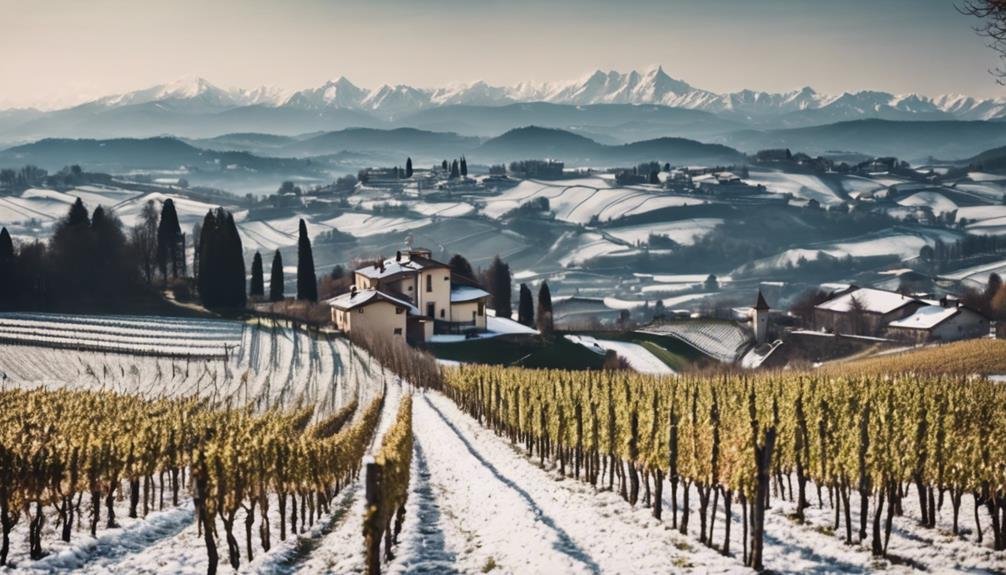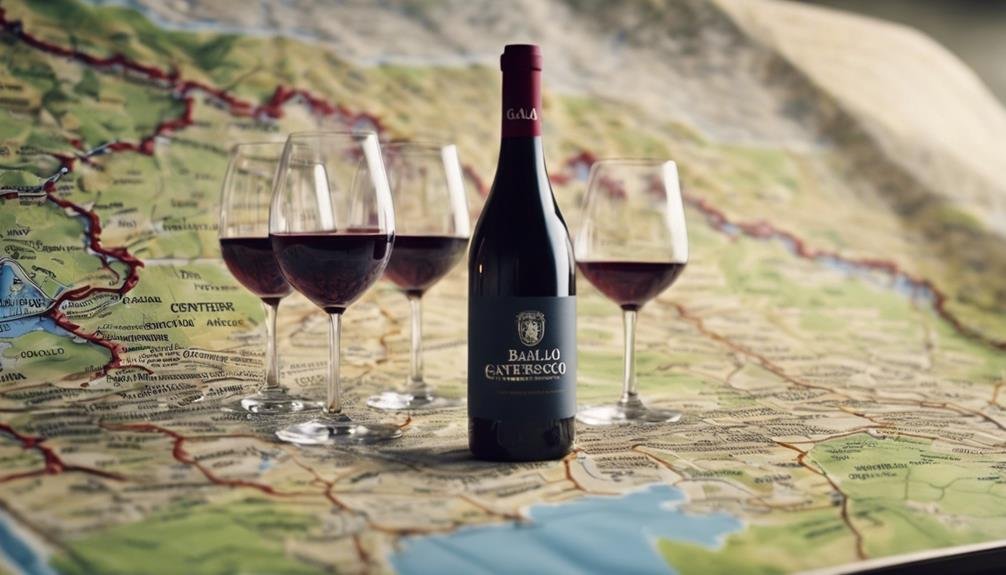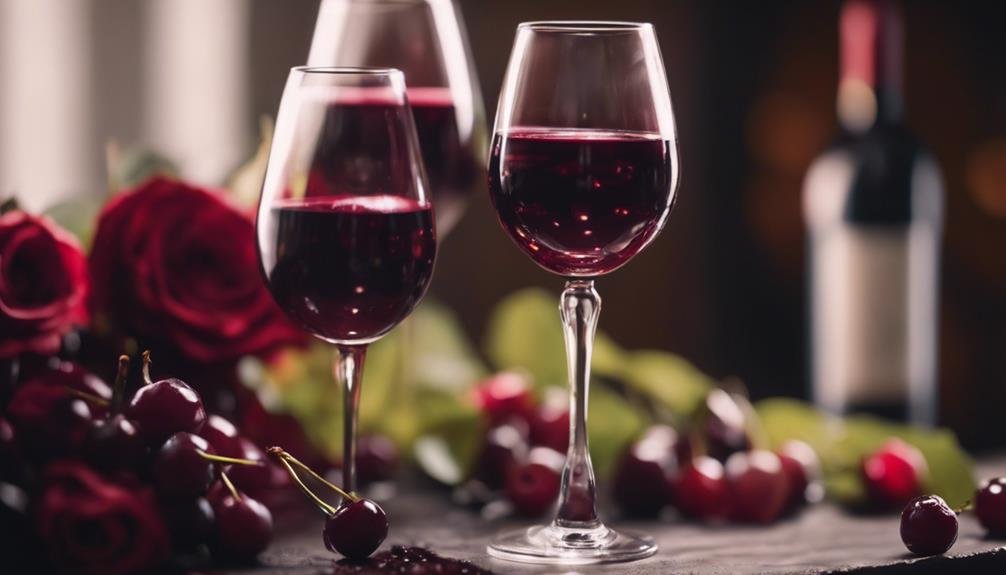Explore the mystique of Nebbiolo, a revered grape with deep roots in Italy's Piedmont region. This varietal, synonymous with Barolo and Barbaresco wines, boasts a terroir-expressive nature, offering complex flavors of cherry, coffee, and earthy undertones. Thriving in Piedmont's unique soils and climate, Nebbiolo has high tannins that soften with age, making it a sought-after choice. Beyond Italy, regions like California and Victoria State embrace its allure. Notable authors like Jancis Robinson shed light on its intricacies, while vineyard tours in Barolo provide firsthand experiences. Immerse yourself in the enigmatic world of Nebbiolo for a deeper appreciation.
Historical Origins of Nebbiolo
The historical origins of Nebbiolo can be traced back to the 13th century, marking its first documented reference in the world of wine. This noble grape has deep Italian heritage, primarily cultivated in Piedmont. Known for its terroir-expressive nature, Nebbiolo thrives in the unique soils and climate of this region.
The grape derives its name from the Italian word for fog, 'nebbia,' possibly alluding to the misty conditions often present during harvest. With a rich history dating back centuries, Nebbiolo has become synonymous with premium Italian wines like Barolo and Barbaresco.
Its distinct flavors of cherry, coffee, and earthy undertones have captivated wine enthusiasts worldwide, solidifying Nebbiolo's reputation as a sophisticated and complex varietal.
Nebbiolos Distinct Taste Profile
Nebbiolo's distinctive taste profile is characterized by its high tannins and complex flavors of cherry, coffee, and earthy undertones, making it a sought-after varietal for wine enthusiasts seeking a sophisticated and robust drinking experience. The earthy undertones in Nebbiolo wines add depth and complexity, complementing the fruity and aromatic notes.
When paired with food, Nebbiolo's high tannins make it a great match for fatty, buttery, or oily dishes. This wine shines when enjoyed alongside rustic Italian cuisine, Chinese stir-fries, or flavorful Asian dishes. Nebbiolo's grippy tannins provide a unique mouthfeel that enhances the overall dining experience, making it a versatile and exciting choice for food lovers looking to elevate their meals with a touch of elegance.
Global Regions Producing Nebbiolo

A variety of regions across the globe are known for producing Nebbiolo wines, each offering unique expressions of this terroir-driven grape varietal. Nebbiolo's international appeal has led to its cultivation in various countries, resulting in Nebbiolo's evolving styles.
While Piedmont, particularly Barolo and Barbaresco, remains the heartland of Nebbiolo production, New World regions like California and Mexico have also embraced this grape, showcasing their own interpretations. Victoria State in Australia is known for juicy, floral styles of Nebbiolo, while Chiavennasca in Valtellina produces elegant wines.
These diverse expressions of Nebbiolo worldwide demonstrate the grape's adaptability to different climates and soil types, captivating wine enthusiasts with a range of flavors and characteristics.
Intriguing Facts About Nebbiolo
With a history shrouded in mystery and a flavor profile that intrigues the palate, Nebbiolo stands out as an alluring and enigmatic grape varietal. Known for its aging potential, Nebbiolo wines are revered for their ability to evolve and improve over time.
This grape variety often produces wines with high tannins that soften with age, allowing for complex and harmonious flavors to develop. Nebbiolo wines from prestigious regions like Barolo and Barbaresco in Piedmont are particularly renowned for their exceptional aging capabilities, sometimes lasting for decades.
The aging process not only refines the tannins but also enhances the wine's aromatic profile, creating a truly remarkable drinking experience that captures the essence of this captivating grape varietal.
Notable Sources for Nebbiolo Enthusiasts

Renowned for their depth of knowledge and expertise in the world of Nebbiolo wines, esteemed sources provide invaluable insights for enthusiasts seeking to deepen their understanding of this enigmatic grape varietal. Notable authors such as Jancis Robinson and Karen MacNeil offer detailed works like 'Wine Grapes' and 'The Wine Bible' that explore the intricate details of Nebbiolo, from its history to tasting notes.
Additionally, vineyard tours in regions like Barolo and Barbaresco in Piedmont provide firsthand experiences to witness the unique terroir that shapes Nebbiolo wines. These tours allow enthusiasts to see the vineyards, taste the wines, and understand the winemaking process, adding a new dimension to their appreciation of Nebbiolo.
Frequently Asked Questions
What Makes Nebbiolo Wines Have a Light Appearance and Aroma?
Nebbiolo wines exhibit a light appearance and aroma due to the grape variety's thin skin and delicate nature. This, coupled with a longer aging process, highlights the terroir influence, enhancing flavors of cherry, coffee, and earth. Ideal with fatty foods.
How Do Barolo and Barbaresco Differ in Their Production Methods?
Barolo and Barbaresco diverge in production methods, contrasting traditional and modern techniques. Vineyard location influence plays a pivotal role, shaping the distinct terroir expressions in these renowned Nebbiolo wines from Piedmont, Italy.
Why Is Nebbiolo Rarely Grown Outside of Piedmont?
Nebbiolo is rarely grown outside Piedmont due to climate limitations and soil composition. Its specific requirements, including cooler temperatures, calcareous soils, and unique terroir, make successful cultivation challenging in other regions, leading to its restricted growth.
What Are the Key Characteristics of Nebbiolo From Victoria State in Australia?
Victoria State's Nebbiolo showcases a unique flavor profile influenced by its terroir, offering elegant and juicy expressions. Characterized by floral notes and vibrant fruitiness, these wines reflect the region's distinct climate and soil.
How Has Modern Winemaking Affected the Tannins in Young Nebbiolo Wines?
Modern winemaking techniques have softened tannins in young Nebbiolo wines, enhancing their approachability. Through controlled maceration, shorter fermentation times, and oak aging, winemakers achieve a balance between youthful expressions and flavor development, making them more palatable sooner.
Conclusion
To sum up, Nebbiolo wine continues to captivate wine enthusiasts with its rich history, distinctive taste profile, and global appeal. Its enigmatic allure and complex flavors make it a sought-after varietal for those seeking a unique sensory experience.
Whether enjoyed in traditional Piedmont regions or in emerging New World vineyards, Nebbiolo remains a fascinating and versatile wine that offers a truly exceptional drinking experience. Cheers to the enigmatic beauty of Nebbiolo!
